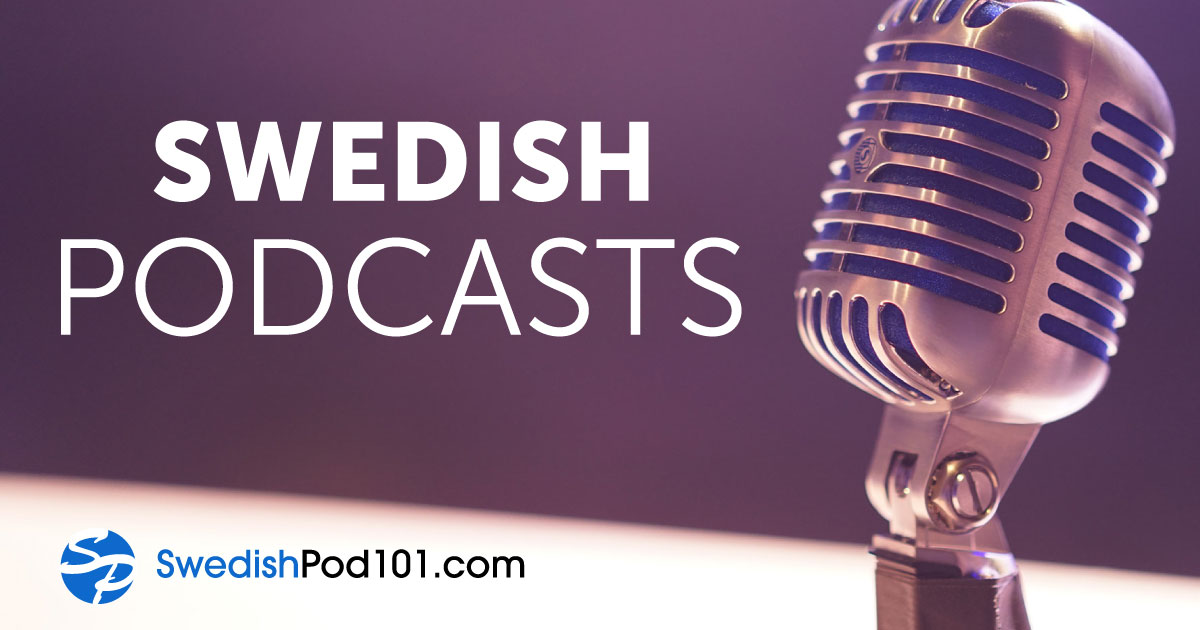
Ever thought to yourself: What is a verb?
In addition to nouns, verbs are one of the most important parts of any sentence. They are the words we use to talk about actions (sjunga – sing), states of being (existera – exist), or occurrences (utveckla – develop), and they have to agree with the subject, which is who or what performs the action described.
Basically, all sentences need a verb to be complete, and this is why it’s so important to get them right when studying a foreign language!

Verbs and tenses in Swedish are actually not as complicated to learn as those of other languages—and in this article, you’ll find out why. We’ll look at how to form the main tenses in Swedish and discuss when to use each one; by the end, you’ll be able to use Swedish verbs with no problems!
This lesson is not going to be complicated or grammar-heavy at all, and we’ll explain each concept thoroughly so that you can easily grasp them and put them to good use throughout your Swedish language-learning journey.
 Table of Contents
Table of Contents
1. The Use of Tenses in Swedish
Verb tenses are used to express when an action takes place. As you know, there are three main concepts involved here: the present, the past, and the future.
In Swedish, there are five main tenses: one to express events in the present, three for the past (the past perfect, the past imperfect, the pluperfect), and different ways to express actions and occurrences that have not yet happened in the future.
Let’s have a look at these Swedish-language tenses in detail.

2. Presens
The present tense (presens in Swedish) is used to talk about events that are happening at the moment of speaking, routines, and events in the near future. In Swedish, there’s only one present tense form, which corresponds to both the simple present (I eat) and the present continuous (I am eating) in English.
The Swedish present tense is formed by taking the stem of the verb (which is also the imperative form) and adding -r to it:
- tala (speak)
STEM: tala
PRESENT: talar
If the stem of the verb ends in a consonant, then we add -er to it:
- stänga (close)
STEM: stäng
PRESENT: stänger
There is no extra -r after stems that end in -r:
- lära (learn)
STEM: lär
PRESENT: lär
Note that Swedish verbs only have one ending, which remains the same for all personal pronouns: Regardless of whether the subject is jag (I), hon (she), or de (they), the ending remains -r!
| Personal Pronoun | Tala (Speak) | Stänga (Close) |
| Jag (I) | talar | stänger |
| Du (You) [s] | talar | stänger |
| Han / Hon (He / She) | talar | stänger |
| Vi (We) | talar | stänger |
| Ni (You) [p] | talar | stänger |
| De (They) | talar | stänger |
3. Past
There are three Swedish past tenses: the preteritum (past imperfect), the perfekt (present perfect), and the pluskvamperfekt (past perfect). Let’s have a look at when to use each one and how to form them!
A- Preteritum
The preterite (or imperfect) tense is used to talk about an event that happened in the past and is now over.
Often, but not always, Swedes specify this by using an expression of time: igår (yesterday), förra veckan (last week), under 1702 (in 1702), på 1600-talet (in the seventeenth century), etc.
Let’s learn the rules for forming the preterite (remember, Swedish verbs take the same ending for each person/subject):
- For stems (imperatives) that end in a vowel or in most consonants, we just need to add a -de. Imperative + -de = Preteritum. If the stem ends with double -nn or -mm, we remove one and add -de (e.g. känna – feel).
Sluta → Slutade (Stop → Stopped)
Krama → Kramade (Hug → Hugged)
Stanna → Stannade (Stay → Stayed)
Ring → Ringde (Call → Called)
Känn → Kände (Feel → Felt)
Följ → Följde (Follow → Followed)
- If the stem ends in a k, p, s, or t, we add a -te instead of a -de.
Imperative + -te = Preteritum.
Tänk → Tänkte (Think → Thought)
Köp → Köpte (Buy → Bought)
Läs → Läste (Read → Read)
Byt → Bytte (Change → Changed)
- With short verbs, we add -dde. For example: Imperative + -dde = Preteritum.
Tro → Trodde (Believe → Believed)
Bo → Bodde (Live → Lived)
Klä → Klädde (Dress → Dressed)
- And finally, there are irregular verbs. At least you’ll only have to remember one form!
Exceptions:
Skriv → Skrev (Write → Wrote)
Drick → Drack (Drink → Drank)
Var → Var (Be → Was)
Gör → Gjorde (Do → Did)Ha → Hade (Have → Had)

To write
B- Perfekt
In Swedish, the present perfect tense is similar to its English equivalent. It’s used to talk about actions and events that started sometime in the past and might or might not still be happening now.
With this tense, we can use an expression of time that does not refer to a specific moment in the past—redan (already), tidigare (earlier), nyss (recently)—or one that refers to a time that isn’t over yet, like i dag (today), den här veckan (this week), or i år (this year).
This tense consists of two parts: the verb har (have) and the past participle of the verb you’re using.
To form the past participle, just add a -t to the verb stem (imperative form).
For example:
Sluta → Slutat (Stop → Stopped)
Krama → Kramat (Hug → Hugged)
Stanna → Stannat (Stay → Stayed)
Ring → Ringt (Call → Called)
Of course, there are irregular verbs that you’ll have to learn by heart (just as there are in English!).
Once you have the past participle, you can form the perfect tense with the verb har:
- Jag har talat…
I have spoken…
- Du har slutat…
You have stopped…
C- Pluskvamperfekt
This tense is used to talk about an action that was completed before another event or action in the past, just like the past perfect in English: He had gone when I arrived.
To form it, we simply take the past participle of the verb and add the past tense form of the verb har: hade (to have, had).
- Jag hade talat…
I had spoken…
- Du hade slutat…
You had stopped…
Have a look at the table below, where you’ll find examples of the perfekt and pluskvamperfekt.
| Personal Pronoun | Present Perfect: Har | Past Perfect: Hade | Tala (To speak) |
| Jag (I) | har | hade | talat |
| Du (You) [s] | har | hade | talat |
| Han / Hon (He / She) | har | hade | talat |
| Vi (We) | har | hade | talat |
| Ni (You) [p] | har | hade | talat |
| De (They) | har | hade | talat |

I had spoken.
4. I futurum
As we already mentioned, it’s quite common to use the present tense (usually together with an expression of time indicating the future) to talk about future actions or events.
That said, there are also other ways of expressing it:
- tänker (implies the intention of the subject) + INFINITIVE
Vi tänker flyga hem.
We’re intending to fly home.
- ska (implies a stronger intention of the subject or someone else) + INFINITIVE
Jag ska resa till Amerika i höst.
I’m going to America in the fall.
- kommer att (used for prediction, no intention implied) + INFINITIVE
Du kommer att tycka om min vän.
You will like my friend.
5. Hjälpverb
Auxiliary verbs, or “helping verbs,” are used a lot in the Swedish language. They “help” the main verb describe an action or a state in a particular aspect. In English, the main auxiliary verbs are “to be,” “to do,” and “to have,” but there are also “will,” “shall,” “can,” etc.
In Swedish, these verbs are often irregular, so here’s a table with their conjugations!
| Infinitiv | Imperativ | Presens | Preterirum | Supinum | |
| INFINITIVE | IMPERATIVE | PRESENT | PAST TENSE | PAST PARTICIPLE | |
| OUGHT TO | Att böra | . . . | Bör | Borde | Bort |
| MAY | Att få | . . . | Får | Fick | Fått |
| HAVE | Att ha | . . . | Har | Hade | Haft |
| CAN | Att kunna | . . . | Kan | Kunde | Kunnat |
| WILL, SHALL | Att skola | . . . | Ska | Skulle | Skolat |
| WILL, WANT | Att vilja | . . . | Vill | Ville | Velat |
| MUST | . . . | . . . | Måste | Måste | . . . |
| NEED | Att behöva | Behöv | Behöver | Behövde | Behövt |
| USED TO | Att bruka | Bruka | Brukar | Brukade | Brukat |
| START | Att börja | Börja | Börjar | Började | Börjat |
Remember, these verbs are used with the infinitive form of the main verb:
- Jag kan tala.
I can speak.
- Hon ska tala.
She will speak.
- Han vill inte tala.
He does not want to speak.
- Vi behöver tala.
We need to speak.

We need to speak.
6. Swedish Tenses: A Summary
We hope that this short article was of help to you in gaining some insight into Swedish tenses and how to use them to talk about the past, present, and future!
As we’ve seen, learning how to use verbs and verb tenses in Swedish is actually quite simple! All you need to learn is one ending for all personal pronouns…and some irregular verbs! Not too complicated, after all!
If you want to learn more about verbs and have access to much more Swedish learning material and info, visit SwedishPod101.com. Here, you’ll find lessons for learners at every level, grammar explanations, word lists, a Swedish-English dictionary, and much more.
So what are you waiting for? Start learning and practicing Swedish with us, and you’ll start to improve every day until you’ve mastered the use of Swedish verbs and tenses!
Before you go, let us know in the comments how you feel about Swedish tenses. More confident, or do you still have questions? We’d be glad to help!










